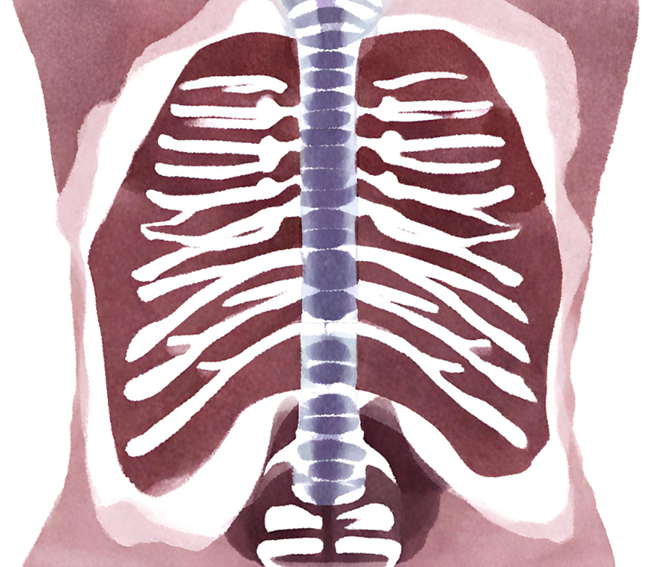Endometriosis is a common disease, affecting up to 10% of women. It is characterized by the presence of tissue similar to the lining of the uterus (the endometrium) forming abnormal growths elsewhere in the body. Usually endometriosis growths/lesions are found in the pelvis, most commonly in the cul-de-sac (between the rectum and the back wall of the uterus), the ligaments of the pelvis, the bladder, the ovaries and tubes, and the sigmoid colon.
Endometriosis lesions can more rarely be found outside of the pelvis, and the most common type of extrapelvic endometriosis is thoracic endometriosis. Although thoracic endometriosis is relatively rare, there has been an increase in diagnosis in recent years, probably because of increased awareness among medical professionals that endometriosis can occur outside of the pelvis. Thoracic endometriosis is often found in conjunction with severe pelvic endometriosis.
The average onset of symptoms of thoracic endometriosis is 35 years old, much later than for pelvic endometriosis, where symptoms often begin in adolescence. It is not clear why this is the case. In addition, the majority of thoracic endometriosis is right-sided, with a smaller number of cases being left-sided or bilateral.
Symptoms and Clinical Presentation
The most common symptom of thoracic endometriosis is catamenial chest pain, which is chest pain occurring right before or during menstruation. In one study, 80% of women with thoracic endometriosis had catamenial chest pain. In another study, 90% of women had chest pain, 30% had shortness of breath, and 7% coughed up blood. These symptoms occurred more often during menstruation, but were not necessarily limited to menstruation. In 40% of women, chest pain was the only symptom of thoracic endometriosis.
The four main clinical entities associated with thoracic endometriosis are catamenial pneumothorax, catamenial hemothorax, catamenial hemoptysis, and lung nodules. Of these, catamenial pneumothorax has been the most researched. This is when the lung collapses during menstruation. It is considered to be catamenial when the collapse occurs during the window of 24 hours prior to the onset of menstruation to 72 hours after onset. The majority of catamenial pneumothorax is caused by thoracic endometriosis; however, not all pneumothorax associated with endometriosis is catamenial. In one study of 150 thoracic endometriosis patients, 37% of the pneumothoraces were catamenial, and 63% were non-catamenial. Pneumothorax typically causes chest pain and shortness of breath.
Catamenial hemothorax is bleeding between the chest wall and the lung that occurs during menstruation. This is a rare cause of pleural effusion (fluid around the lung), and like pneumothorax, usually causes chest pain and shortness of breath. Catamenial hemoptysis is coughing up blood during menstruation, and is usually associated with chest pain and shortness of breath. Catamenial hemothorax and catamenial hemoptysis occur in thoracic endometriosis less frequently than catamenial pneumothorax. Pulmonary nodules are one of the least frequent manifestations of thoracic endometriosis, and are masses in the lung that can be mistaken for malignancy. They can be asymptomatic, or sometimes cause coughing up blood.
In most if not all cases of thoracic endometriosis, lesions are also found on the diaphragm. In the majority of women, diaphragmatic endometriosis penetrates through the diaphragm. However, in a small number of women, the endometriosis lesions are found only on the visceral (abdominal/pelvic) side of the diaphragm, or only on the pleural (thoracic/lung) side. Not all women with diaphragmatic endometriosis will also have thoracic endometriosis. The symptoms of endometriosis on the diaphragm are similar to the symptoms of thoracic endometriosis, with chest pain during menstruation. This pain may radiate to the shoulder, neck or arm.
In rare cases, endometriosis on the pericardium has been reported (here, and here). The pericardium is the membrane that surrounds the heart. These women also had diaphragmatic endometriosis, and one of them had severe pelvic endometriosis, and the other had an endometrioma in her liver.
How Does Thoracic Endometriosis Develop?
A common theory about the development of endometriosis, known as Sampson’s theory, suggests that retrograde menstruation, menstrual blood flowing backwards (away from the uterus) through the Fallopian tubes towards the pelvic cavity, deposits fragments of endometrium into the pelvis, which can then implant and grow into lesions. This theory has many flaws, as discussed here. The existence of endometriosis outside of the pelvis is one of several facts about endometriosis that cannot be explained by Sampson’s theory.
So how does endometriosis outside of the pelvis develop? There are three main theories, and it may be through one or a combination of these that endometriosis develops in the thorax. The fact that thoracic endometriosis develops later than pelvic endometriosis may suggest that there is something fundamentally different about the way it develops. The migration theory suggests that endometriosis moves through the peritoneum (the lining of the pelvis) to the diaphragm, and from there, can move into the thorax through small holes in the diaphragm. The embolization theory suggests that endometriosis can be transplanted to the thorax from the pelvis through the lymph circulation, or the blood. Lastly, the metaplasia theory suggests that certain cell types can be transformed or changed into endometriosis. Clearly, more research is needed to delineate how thoracic endometriosis develops, and even how pelvic endometriosis develops, as this is not fully understood either.
Diagnosis
The definitive diagnosis of thoracic endometriosis, like all endometriosis, is through biopsy of endometriosis lesions/growths that have been removed surgically. Video-assisted thoracoscopic surgery can be used to visualize and remove endometriosis growths in the thorax. This type of surgery is similar to pelvic laparoscopy, where a small video camera scope allows the visualization of the surgical area, and instruments are inserted through small separate incisions. However, without surgery, a tentative diagnosis can be made through the clinical history and sometimes imaging results. In a woman with pelvic endometriosis, thoracic endometriosis may be suspected if catamenial chest pain is present, or any of the other clinical entities described above. Chest x-rays can show pneumothorax, pleural effusions, or lung nodules. CT scans may show certain findings characteristic of thoracic endometriosis, but sometimes CT scans are normal when a woman is not menstruating. MRI can also be helpful.
Treatment
Hormone therapy such as birth control pills, depo-provera, and Lupron are associated with greater than 50% recurrence of symptoms within six months after treatment was stopped. Video-assisted thoracoscopic surgery has been shown to be a safe option for treatment of thoracic endometriosis, and it can be combined with pelvic laparoscopy in the same surgery if pelvic endometriosis also needs to be treated. As with all surgery to excise endometriosis, the goal is to locate all of the lesions and remove them completely, in order to minimize recurrence. Most studies of surgical treatment of thoracic endometriosis have a fairly short followup, typically median followup of 18 months, and the number of patients in the studies is usually a small number, so it is difficult to draw robust conclusions about the long-term effectiveness of surgery. In one study, all patients had improvements in symptoms after surgery, but two out of 25 had recurrence at nine and twelve months respectively. Overall, though, surgical excision of thoracic endometriosis appears to be effective in the majority of cases.
We Need Your Help
More people than ever are reading Hormones Matter, a testament to the need for independent voices in health and medicine. We are not funded and accept limited advertising. Unlike many health sites, we don’t force you to purchase a subscription. We believe health information should be open to all. If you read Hormones Matter, like it, please help support it. Contribute now.
Yes, I would like to support Hormones Matter.
Image created in Canva AI.
This article was published originally on July 16, 2016.














After a hysterectomy I was informed that I have severe Endometriosis in my bowel. Next month I go into hospital for investigation. I know little about it. Is there more information iI need to be aware of ? As of yet I haven’t met my gastroenterologist.
Some months ago my diaphragmatic pain flared up again, by accident I tried “Maximum Strength Aspercream with Lidocaine”. Applying it twice a day across the lower back and up to the neck for 3 days stopped the headaches, neck, and breathing pain. I’ve been using the cream (which is available in CVS and most supermarkets) for a few cycles and seems to be working.
For my severe endo related menstrual pain I am taking a serotonin supplement (5-HTP 100 mg once a day). There is a lot of research linking endo to lowered serotonin level which is linked a lowered pain threshold. What a change, her pain became much more manageable.
I am not sure why my doctor don’t tell my about this. I want to pass what we found in case others suffering like us can find some relief.
They just found endo in my lungs, I’m so scared.. I believe I got it from having a hysterectomy because they used the Davinci robot and pulled my uterus up and out of my chest cavity.. “I believe spreading it” If any one has any info on any of this please contact me.. Thank you Lisa
Hi Lisa,
I’m sorry to hear you are dealing with thoracic endo! There are a few doctors around the US who can help you with this condition. However, it did not arise because of your hysterectomy–that is not how a hysterectomy is done. The uterus never comes into contact with anything in your chest cavity. The chest cavity is separated from the abdomen by the diaphragm. They will pull the uterus out of the abdomen or out of the vagina during a hysterectomy, depending on what type of surgery you had–I think the Davinci robot can be used to do vaginal as well as laparoscopic hysterectomies. Nobody really knows exactly how thoracic endo develops, but there are a lot of theories.
Nancy’s Nook on Facebook is an excellent group to learn more about effective endo treatment and which doctors specialize in thoracic endo: https://www.facebook.com/groups/418136991574617/. You may need to travel to access good care. There is also this group, which is specifically about thoracic endo: https://www.facebook.com/groups/735515309971721/.
I went undiagnosed for nearly two decades because the lack of knowledge the doctors have about this cruel disease endometriosis. My endometriosis was so severe it has travelled to my liver.
I have back pain chest pain liver pain frequent urination leg pain depression.
I’m so angry that it took so long to be diagnosed this illness has completely taken over my life and destroyed normality something needs to be done.
Fantastic read, I have extra pelvic endo , after subtotal hysto, ive been complaining of chest pain for over 7 years, coughed up blood prior to my hysto, not so much now but pain just as bad, so i asked for a scan , the CT showed multiple sub centimetre pulmonary nodules , these existing nodules are not ground glass in appearance, and I’ve advised by Radiologist its probably not endo, more Rheumatic , however believe they are endo , I know how endo feels , how do I go about proving this ? Vats ?
* additionally I had heart surgery (PDA Closure) as a child, I have scar tissue in my chest, my old scars now hurt, I have high level of antibodies in blood (consistently for years) but they say its not lupus. Your opinion would be most appreciated
Many Thanks Candice
Yes, typically the definitive diagnosis of endo is surgical, so it would require VATS to prove those lesions are endo. However, since it is fairly invasive, you may have trouble convincing someone to do a surgery if they don’t have a high index of suspicion of endo. If you can find an endo specialist who has experience with thoracic endo, their opinion would be extremely useful. For example, Dr. Sinervo and his team at CEC in Atlanta. They will also do a free records review for you.
I have thoracic endometriosis. I’ve tried hormone treatments and surgery. I am still symptomatic with mini lung collapses often. Is the best treatment to have the ovaries removed?
I’m trying to do research to find other options than Lupron to treat my supposed Thoracic Endo dx. I’ve had a VATS & both chemical & mechanical pleurodesis performed, but have persistent pneumothoraces 3.5 years later. At the time the VATS was performed, the surgeon said he saw no evidence of thoracic endo, however there were fenestrations in my diaphragm that were repaired. I’m seriously frightened by the purported side effects of Lupron, but that’s what every doctor seems to be pushing me towards. I refuse, but know I need to do something as these recurrent pneumos aren’t great to deal w/either. Are there any studies that you can suggest that are looking into other tx options? I’d love to read and then discuss with my healthcare providers. I firmly believe healthcare should be made with BOTH doctor and patient input, and I want to be as knowledgable as I can when speaking to my doctors.
Would thoracic endometriosis look like “ground glass opacities?!”
Yes, it can.
I have stage 4 endometriosis, had a laparoscopic surgery 4 years ago for fertility treatments that failed, was started on birth control for perimenopausal symptoms but recently stopped it 6 months ago…had a recent period where I could not breath and had chest pain, was ordered an X-ray and ct and found some atelectasis/scarring in the right medial lung and an elliptical density measuring 2.1cm x 1.cmx1.5cm in right major fissure…could this be endometriosis? I also have a 0.2 cm nodule in my left lung.
Hi Jen,
You will need to see a physician who treats thoracic endometriosis. Some of these physicians will do a free records review, such as Dr. Sinervo in Atlanta. I would suggest joining the group Nancy’s Nook on Facebook for more information.